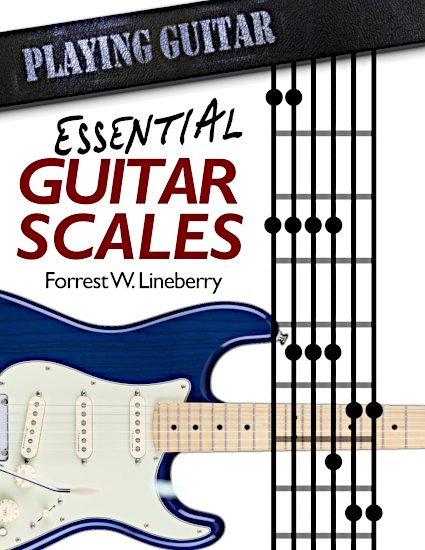CAGED+
There’s no catchy name for this system, so I decided to start calling it CAGED+, because it adds two chord shapes to the five associated with CAGED Basic. This coupled with working the arpeggio and scales in seven patterns effectively eliminates the need to shift the hand away from the chord location to access the desired notes. There is also the added benefit that the scales broken into seven shapes begin to look more symmetrical on the fretboard.
Let’s take a look at the fingering for the E chord shape from the CAGED system (numbers represent fingers 1-4):

The chord shape dictates which finger plays the root (1st finger on the E-string) and the frets covered by the 2nd and 3rd fingers (4th and 5th frets). The location of the lowest root in the chord shape and finger used to play that note will be used for naming each of the seven positions used in this system. The CAGED E shape becomes position 1-E — the root note is played by the 1st finger on the E-string.
Using the chord fingering to establish our fretboard position results in new shapes for the arpeggio and scales:



The E shape arpeggios and scale shapes from the CAGED system become position 2-E in CAGED+ and are based around a new chord shape:


The remaining shapes can be worked out in the same manner:










The CAGED+ shapes have a perfect 1-to-1 relationship between the fingerings for the chord and the fingerings for the arpeggio and scale shapes. The trade-off is that most of the CAGED+ shapes require finger stretches and a more open left hand position if any sort of fluidity or speed with the notes is expected. Stretching the fingers and opening the hand can be difficult or uncomfortable for many players, but for those who are able to make use of these shapes, this system has a lot to offer. The two extra chord shapes added to the CAGED chords are commonly used as 1st inversion major chords so they are important to learn even if you don’t adopt the system as a whole.Some players object to the CAGED+ fingerings only because the required stretching happens most often with the 4th finger. They feel that 1st finger stretches are more ergonomic and less likely to cause injury to the hand and wrist over time. For those players, the 3-notes-per-string system is more attractive.

Book Title
Essential Guitar Scales
The scales you need, how to learn them, how to practice them, how to USE them.
Sell Link
Coming in early 2020!
Sample Chapter Links
Sample Chapters

